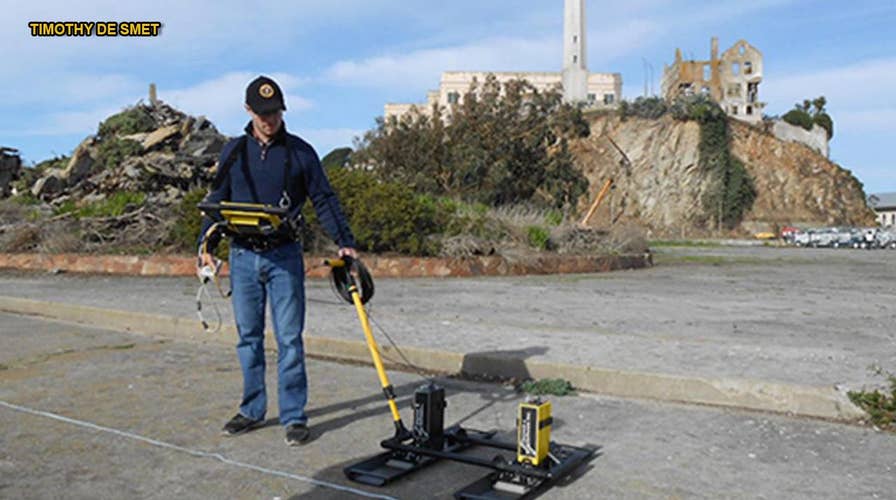Amazing Alcatraz discovery: Lasers reveal long-hidden military tunnel and fortifications
Experts have harnessed technology to unlock the hidden military secrets of Alcatraz Island. Using ground penetrating radar and laser scanning technology, experts performed high-tech scans of the penitentiary's former recreation yard to reveal a long-hidden military tunnel and fortifications beneath the prison. Binghamton University Archaeologist Timothy de Smet, said that the structures were in incredibly good condition.
Archaeologists have harnessed radar and laser scanning technology to reveal a long-hidden military tunnel and fortifications beneath Alcatraz.
Prior to becoming the site of the infamous high-security prison, Alcatraz Island was home to a 19th-century coastal fortification, known as the Citadel or Fort Alcatraz. Designed to the protect San Francisco Bay, construction of the island's defenses began in 1860 and increased during the Civil War. There were 140 artillery pieces on the island at the height of its fortification, according to the National Park Service. However, only a few remnants of the fort are now visible.
To unlock Alcatraz’s hidden history, experts performed high-tech scans of the penitentiary’s former recreation yard. In addition to radar and laser scans, they also took old digitized maps and linked them to a system of coordinates. Their research revealed a “bombproof” earthwork traverse and its underlying vaulted brick masonry tunnel, as well as ventilation ducts, according to a statement.
MYSTERIOUS TUNNELS DISCOVERED IN FLORIDA
Binghamton University Archaeologist Timothy de Smet, who led the research, said that the structures were in incredibly good condition. “I was surprised for several reasons,” said de Smet, in the statement. “The remains of these historical archaeology features were just a few centimeters beneath the surface and they were miraculously and impeccably preserved. The concrete veneer of the Recreation Yard floor is incredibly thin and, in fact, in places sitting directly atop the architecture from the 1860s.”

A view of Alcatraz Island. The ruined warden's mansion is in the center of the picture. (Chris Ciaccia/Fox News)
The construction of the prison in the early 1900s largely destroyed the military installation. “The area was essentially bulldozed from the former military installation to the modern prison we see today,” explained de Smet. “In converting the area to a prison, the vast majority of the previous military history of the island had been erased, but we wondered if perhaps something of that significant time in both the islands and American history remained, but buried and preserved beneath the subsurface.”
Ground penetrating radar and laser scanning technology help archaeologists avoid expensive and highly disruptive excavations. “With modern remote sensing methods like these, we can answer fundamental archaeological research questions about human behavior, social organization and cultural change through time without costly and destructive excavation, thereby preserving these non-renewable archaeological resources in the ground - or in situ as we say in the field - for future generations,” said de Smet.
MYSTERIOUS UNDERGROUND CHAMBER DISCOVERED AT CANADIAN PROVINCIAL ASSEMBLY
The researchers, who include experts from Texas A&M University, the Concrete Preservation Institute and the National Park Service, published their findings in the journal Near Surface Geophysics.

Although famous for its former high-security prison, Alcatraz Island was previously the site of a 19th-century military installation. (Chris Ciaccia/Fox News)
In 2015, ground penetrating radar was also used to locate the remains of the Great Synagogue of Vilna (Vilnius) in Lithuania, more than 70 years after its destruction by the Nazis.
Other famous sites have been revealing their subterranean secrets. Last year, a series of mysterious rooms was uncovered for the first time in 250 years at Blenheim Palace, the birthplace of Winston Churchill in Oxfordshire, U.K. The rooms are part of a “lost” ground floor within the site’s Grand Bridge. Flooded when water levels were raised to create lakes in the 18th century, the rooms were rediscovered thanks to a massive dredging effort to remove silt from the lakes.
MYSTERIOUS HIDDEN ROOMS UNCOVERED AT CHURCHILL’S PALACE BIRTHPLACE
Last summer, a mysterious underground vault was discovered on the grounds of the Nova Scotia Legislature in Canada. It’s not clear what the room was used for, although experts think that it may have once served a military purpose.

File photo - The San Francisco skyline is obscured by smoke and haze from wildfires behind Alcatraz Island Wednesday, Nov. 14, 2018, in San Francisco. (AP Photo/Eric Risberg)
Also in 2018, more evidence emerged of a mysterious network of tunnels beneath the historic neighborhood of Ybor City in Tampa, Fla. One theory suggests that the tunnels were used by Prohibition-era smugglers and bootleggers.
Historic tunnels are found in a number of North American cities, such as the Cobble Hill tunnel in Brooklyn. Built in 1844, the massive tunnel beneath a busy Brooklyn street has been described as the world’s oldest subway tunnel.
CLICK HERE TO GET THE FOX NEWS APP

File photo - a view of Alcatraz Island. (AP)
In Canada, a network of early 20th-century utility tunnels beneath the city of Moose Jaw, Saskatchewan, was used as shelter by Chinese immigrants and also by bootleggers in the 1920s. Some anecdotes even link Al Capone to the tunnels, although it has not been proved that the famous gangster visited Moose Jaw.
Follow James Rogers on Twitter @jamesjrogers

